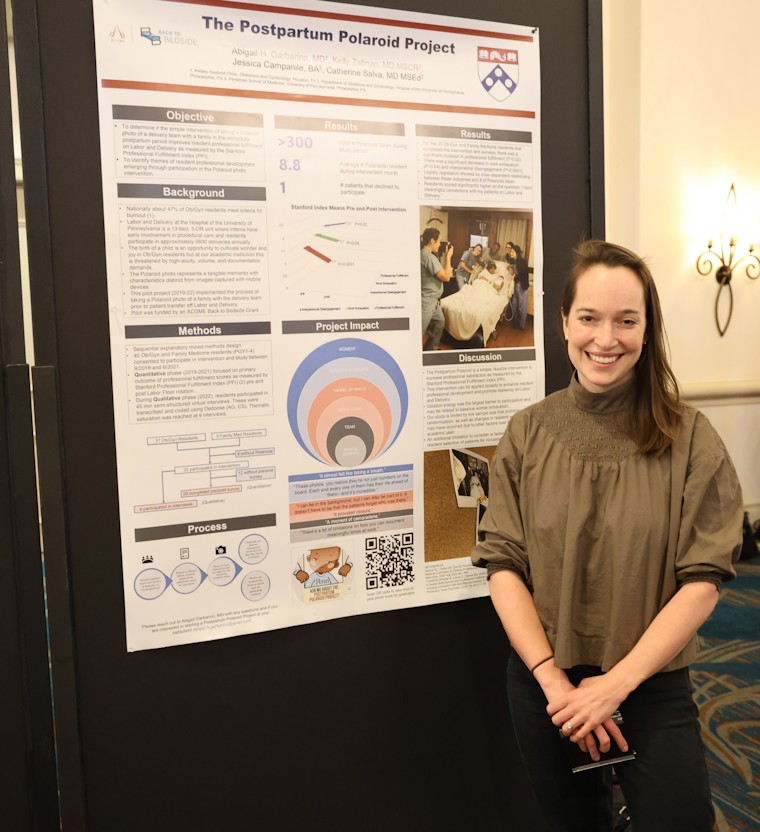The birth of a child is a momentous, miraculous occasion. But it can also be stressful for the residents who are learning how to manage the volume of patients in their caseload and documentation each case requires; 87.5 percent of obstetrics and gynecology residents reported they or a colleague experienced burnout. This project, which was developed initially as part of the ACGME’s , was designed to infuse a moment of joy and reflection into delivery, enhancing the birthing experience for both physician and patient.
Poster Title: The Postpartum Polaroid Project: A Mixed-Methods Study Evaluating Resident Use of Polaroid Photos as an Intervention for Mindfulness in Obstetrics
Primary Author: Abigail Garbarino, MD
Co-Authors: Abigail Garbarino, MD; Jessica Campanile, MD; Kelly Zafman, MD, MSCR; Catherine Salva, MD, MSE
ACGME: Tell us about your academic and professional role.
Dr. Garbarino: I completed this project over all four years of my obstetrics and gynecology residency. I now am an obstetrician-gynecologist for a multispecialty clinic in Houston, Texas.
ACGME: Can you briefly describe your research project for us?
Dr. Garbarino: Our project aimed to create mindful interaction with patients by taking Polaroid photos of the delivery team with the new family they just delivered. Polaroids were given not only to the delivering resident, but to the new family as well.
ACGME: What inspired you to do this project?
Dr. Garbarino: As a first-year resident in obstetrics and gynecology, I was struck by the dissonance between the wonder and joy of childbirth and the frantic nature of my hurried, disconnected, reality with the women I was delivering when I was on labor floor. I wanted to fix this—and also remember my patients! I got the idea at a wedding where the guests took Polaroid photos of themselves and put it in the couples’ guestbook; it was simple, meaningful, and captured a moment in time with a physical memento.
ACGME: What did you discover?
Dr. Garbarino: Taking the time—even with just a few deliveries a month—to document a delivery with a Polaroid significantly increased resident professional fulfillment as measured by the Stanford Professional Fulfillment Index (PFI). Qualitative interviews uncovered many subtle reasons this “works:” the power of the forced pause or “moment,” seeing patients as people outside of the clinical context, taking up space and ownership as a new physician by giving a photo to the family, and the value that current residents place on photo documentation of their clinical role in the hospital (something that is traditionally very limited by HIPPA [the Health Insurance Portability and Accountability Act]).
ACGME: What was the main takeaway?
Dr. Garbarino: Taking a moment to connect with patients through the shared humanity of gathering for a photo is a powerful antidote to the depersonalization, anonymity, and moral dissonance experienced as a resident on a high acuity labor floor.
ACGME: Who could benefit from this research?
Dr. Garbarino: This is easily reproducible on any labor floor, but could also be adapted to other specialties: intensive care unit rotations upon the discharge of a patient, surgery patients at their post-operative visit, etc.
ACGME: Anything else you’d like to add?
Dr. Garbarino: One unexpected outcome was how the project affected medical student learners. Although we did not study their involvement, they ended up an integral part of increasing enthusiasm for the Polaroids. When they were able to participate in the photos themselves and take a copy home, it seemed to leave a lasting impression, especially because for many of them this was the first birth they had witnessed.

